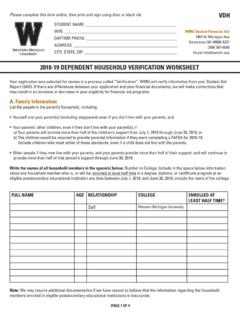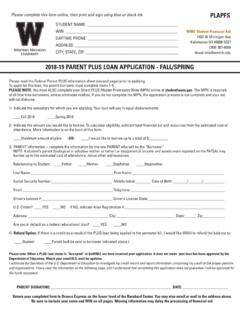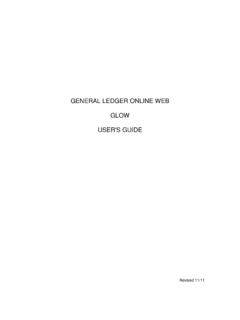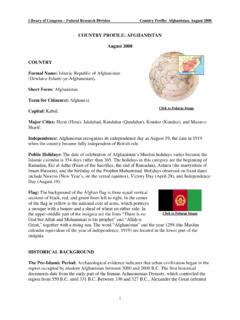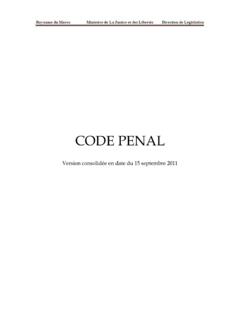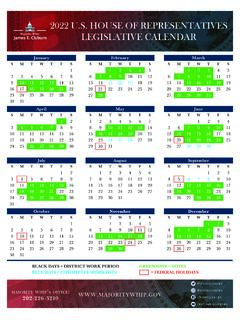Transcription of Qualitative Evaluation Checklist
1 Michael Quinn Patton 2002 1. Determine the extent to which Qualitative methods are appropriate given the Evaluation s purposes and intended uses. 2. Determine which general strategic themes of Qualitative inquiry will guide the Evaluation . Determine Qualitative design strategies, data collection options, and analysis approaches based on the Evaluation s purpose. 3. Determine which Qualitative Evaluation applications are especially appropriate given the Evaluation s purpose and priorities. 4. Make major design decisions so that the design answers important Evaluation questions for intended users. Consider design options and choose those most appropriate for the Evaluation s purposes. 5. Where fieldwork is part of the Evaluation , determine how to approach the fieldwork. 6. Where open-ended interviewing is part of the Evaluation , determine how to approach the interviews.
2 7. Design the Evaluation with careful attention to ethical issues. 8. Anticipate analysis design the Evaluation data collection to facilitate analysis. 9. Analyze the data so that the Qualitative findings are clear, credible, and address the relevant and priority Evaluation questions and issues. 10. Focus the Qualitative Evaluation report. Introduction Qualitative evaluations use Qualitative and naturalistic methods, sometimes alone, but often in combination with quantitative data. Qualitative methods include three kinds of data collection: (1) in-depth, open-ended interviews; (2) direct observation; and (3) written documents. Qualitative Evaluation Checklist Michael Quinn Patton The purposes of this Checklist are to guide evaluators in determining when Qualitative methods are appropriate for an evaluative inquiry and factors to consider (1) to select Qualitative approaches that are particularly appropriate for a given Evaluation s expected uses and answer the Evaluation s questions, (2) to collect high quality and credible Qualitative Evaluation data, and (3) to analyze and report Qualitative Evaluation findings.
3 | 2 | PATTON Interviews: Open-ended questions and probes yield in-depth responses about people's experiences, perceptions, opinions, feelings, and knowledge. Data consist of verbatim quotations with sufficient context to be interpretable. Observations: Fieldwork descriptions of activities, behaviors, actions, conversations, interpersonal interactions, organizational or community processes, or any other aspect of observable human experience. Data consist of field notes: rich, detailed descriptions, including the context within which the observations were made. Documents: Written materials and other documents from organizational, clinical, or program records; memoranda and correspondence; official publications and reports; personal diaries, letters, artistic works, photographs, and memorabilia; and written responses to open-ended surveys.
4 Data consist of excerpts from documents captured in a way that records and preserves context. The data for Qualitative Evaluation typically come from fieldwork. The evaluator spends time in the setting under study a program, organization, or community where change efforts can be observed, people interviewed, and documents analyzed. The evaluator makes firsthand observations of activities and interactions, sometimes engaging personally in those activities as a "participant observer." For example, an evaluator might participate in all or part of the program under study, participating as a regular program member, client, or student. The Qualitative evaluator talks with people about their experiences and perceptions. More formal individual or group interviews may be conducted. Relevant records and documents are examined. Extensive field notes are collected through these observations, interviews, and document reviews.
5 The voluminous raw data in these field notes are organized into readable narrative descriptions with major themes, categories, and illustrative case examples extracted through content analysis. The themes, patterns, understandings, and insights that emerge from Evaluation fieldwork and subsequent analysis are the fruit of Qualitative inquiry. Qualitative findings may be presented alone or in combination with quantitative data. At the simplest level, a questionnaire or interview that asks both fixed-choice (closed) questions and open-ended questions is an example of how quantitative measurement and Qualitative inquiry are often combined. The quality of Qualitative data depends to a great extent on the methodological skill, sensitivity, and integrity of the evaluator. Systematic and rigorous observation involves far more than just being present and looking around.
6 Skillful interviewing involves much more than just asking questions. Content analysis requires considerably more than just reading to see what's there. Generating useful and credible Qualitative findings through observation, interviewing, and content analysis requires discipline, knowledge, training, practice, creativity, and hard work. Qualitative methods are often used in evaluations because they tell the program's story by capturing and communicating the participants' stories. Evaluation case studies have all the elements of a good story. They tell what happened when, to whom, and with what consequences. The purpose of such studies is to gather information and generate findings that are useful. Understanding the program's and participant's stories is useful to the extent that those stories illuminate the processes and outcomes of the program for those who must make decisions about the program.
7 The methodological implication of this criterion is | 3 | PATTON that the intended users must value the findings and find them credible. They must be interested in the stories, experiences, and perceptions of program participants beyond simply knowing how many came into the program, how many completed it, and how many did what afterwards. Qualitative findings in Evaluation can illuminate the people behind the numbers and put faces on the statistics to deepen understanding. 1. Determine the extent to which Qualitative methods are appropriate given the Evaluation s purposes and intended uses. Be prepared to explain the variations, strengths, and weaknesses of Qualitative evaluations. Determine the criteria by which the quality of the Evaluation will be judged. Determine the extent to which Qualitative Evaluation will be accepted or controversial given the Evaluation s purpose, users, and audiences.
8 Determine what foundation should be laid to assure that the findings of a Qualitative Evaluation will be credible. 2. Determine which general strategic themes of Qualitative inquiry will guide the Evaluation . Determine Qualitative design strategies, data collection options, and analysis approaches based on the Evaluation s purpose. Naturalistic inquiry: Determine the degree to which it is possible and desirable to study the program as it unfolds naturally and openly, that is, without a predetermined focus or preordinate categories of analysis. Emergent design flexibility: Determine the extent to which it will be possible to adapt the Evaluation design and add additional elements of data collection as understanding deepens and as the Evaluation unfolds. (Some evaluators and/or Evaluation funders want to know in advance exactly what data will be collected from whom in what time frame; other designs are more open and emergent.)
9 Purposeful sampling: Determine what purposeful sampling strategy (or strategies) will be used for the Evaluation . Pick cases for study ( , program participants, staff, organizations, communities, cultures, events, critical incidences) that are "information rich" and illuminative, that is, that will provide appropriate data given the Evaluation s purpose. (Sampling is aimed at generating insights into key Evaluation issues and program effectiveness, not empirical generalization from a sample to a population. Specific purposeful sampling options are listed later in this Checklist .) Focus on priorities: Determine what elements or aspects of program processes and outcomes will be studied qualitatively in the Evaluation . Decide what Evaluation questions lend themselves to Qualitative inquiry, for example, questions concerning what outcomes mean to participants rather than how much of an outcome was attained.
10 | 4 | PATTON Determine what program observations will yield detailed, thick descriptions that illuminate Evaluation questions. Determine what interviews will be needed to capture participants perspectives and experiences. Identify documents that will be reviewed and analyzed. Holistic perspective: Determine the extent to which the final Evaluation report will describe and examine the whole program being evaluated. Decide if the purpose is to understand the program as a complex system that is more than the sum of its parts. Decide how important it will be to capture and examine complex interdependencies and system dynamics that cannot meaningfully be portrayed through a few discrete variables and linear, cause-effect relationships. Determine how important it will be to place findings in a social, historical, and temporal context.
